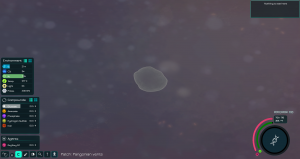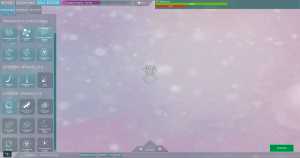Microbe Stage
Previous stage: No earlier stages.
Next stage: Multicellular Stage
The Microbe Stage is the first stage of the game. The stage begins with the first species to exist in the world, fresh from the primordial origins of life exploring the nutrient rich Pangonian Vents. It is here that the player assumes the role of a tiny prokaryotic blob of cytoplasm, one of a few individuals of their species. At this point the player must rely entirely on finding loose glucose to survive as they do not yet possess ways to process other nutrients, and seek out phosphates and ammonia to grow bigger in preperation for reproduction. Once the player has reached a sufficient size they will be capable of reproducing, which will bring the player to the microbe editor should they choose to do so. As the game continues, the player will steadily adapt their cell to better survive in a world that grows gradually harsher each generation, and compete with new species that have arisen from the player's own.
Gameplay
The Microbe Stage takes place in a 3D enviroment viewed from a 2D perspective, as if being viewed from a microscope. Here, the player must steer their cell into brightly colored compound clouds to sustain and grow their cell until they can reproduce. At the beginning of the game there will be no predators, the only dangers being starvation and the occasional toxin. However, as the player reproduces, new competing species will branch away from the player's species and steadily become an increasingly dangerous obstacle for the player to overcome. While at first the player is a tiny cell only capable of consuming glucose ammonia and phosphates, the player will be able to adapt their cell in any way they choose after every reproduction, granting the player new abilities and options as time goes on. This comes at a cost however, as the player cell becomes larger and more complex, it will require more food to sustain. The player must take care to ensure that their cell is always sustainable or they will quickly starve. Additionally, species that arise from your own will inherit your adaptations, so the player must be cautious of how soon they develop things such as weaponry.
Controls
Movement
The Microbe Stage is played using the keyboard and mouse. The cell always faces the mouse cursor's position, while the WASD keys will propel the cell in a direction relative to the cursor's position. For example, pressing the W key will make the cell travel forward towards the mouse cursor. Where as pressing the S key will make the cell travel backwards away from the mouse cursor. These controls allow the player to strategically move their cell to dodge toxin projectiles or position themselves to catch as mnay prey cells as they can. The mouse is also used to interact with the various UI elements on the screen.
Misc.
Pressing the G key will enable Engulfment Mode. In this mode, the cell will begin flashing with a blue overlay, and damage any cells smaller than them they come into contact with. All cells have this ability, regardless of adaptations so it would be wise to avoid approaching larger cells if the player does not have any defenses.
Pressing the E key will expel a toxin projectile from your cell, should your cell possess toxin generating parts.
Using the mousewheel, the player can adjust their field of view. This is very useful for navigating the enviroment around them, or taking a close look at their cell.
Environment
Physical Conditions
TODO
Atmospheric Gasses
These are gasses that are present within a patch, and do not have a physical presence in the game world. These elements act as a passive effect on various processes of the cell, and can be required for certain proteins and organelles to function.
- Oxygen: An important gas for aerobic respiration, oxygen is used by parts such as metabolosomes to perform their purposes. The more oxygen that is present in a patch, the better these parts will perform. Currently, oxygen has no other effect on cells and is at a constant 21% concentration in all patches.
- Nitrogen: A gas used by cells for nitrogen fixation in the synthesis of ammonia. Nitrogen currently has no other effect on cells and is at a constant 70% concentration in all patches.
- Carbon Dioxide: An important gas for chemosynthesis and photosynthesis. Carbon dioxide is currently at a constant 9% concentration in all pacthes.
Compounds
There are several compounds present in the Microbe Stage. Below is a list of all compounds and their uses.
- Glucose: Primary ATP storage for cells, and initial source of food for the player. Glucose is consumed by several organelles and proteins to produce ATP, the most notable being the metabolosomes and mitochondria as they are specifically used for glucose. When the player dies they will respawn with a reserve of glucose within their cell, allowing them to readily resume gameplay without fear of starvation. The player must take care should they rely on the readily available glucose found in the environment, as every generation the global glucose amounts decrease by 80%. Glucose clouds are white in color.
- Ammonia: Vital compounds required for reproduction. Ammonia is used to grow and copy the proteins and organelles within the cell, and can be found readily throughout the environment. Parts such as the nitrogenase and nitrogen fixing plastid can produce ammonia from ATP and nitrogen, saving the player from having to actively seek it out in the environment to reproduce. Ammonia clouds are orange in color.
- Phosphate: Identical in purpose to ammonia, phosphate is a requirement for reproduction. Unlike ammonia however, there are no methods of synthesizing phosphate so it can only be found in the environment or from predation. Phosphate clouds are purple in color.
- Hydrogen Sulfide: An alternative source of ATP for cells, and can be found in high quantities in a select few patches. Should a player intend to use hydrogen sulfide for energy, they must take care to ensure that the patch they inhabit contains the compound. Hydrogen sulfide is only usable if the player posesses chemosynthesizing proteins, otherwise any hydrogen sulfide consumed will be quickly expelled from the cell. Hydrogen sulfide clouds are yellow in color.
- Iron: Another alternative source of ATP, iron is a relatively uncommon resource found in almost, but not all, patches in the world. Unlike any other compound, iron can not only be found in clouds, but also as variably sized chunks that trail iron clouds as they drift. Iron can only be used by a cell if it possesses rustycyanin. Iron clouds appear brown in color.
Editor
The editor is the strategic side of the microbial stage and is accessed whenever the player reproduces. It is in this editor that the player is allowed to evolve their species by placing parts from a list of available proteins or organelles onto their cell. Each generation, the player is given 100 Mutation points or MP that is used as a currency to buy these parts,. The editor is currently divided into three different windows; The report page, the patch map, and finally the editor itself.
Report
The report menu is the first page the player will see upon entering the editor. This page describes all enviromental changes that had taken place before entering the editor such as changes in species population, compound concentration, and etc. The information provided in the report can be helpful, but is not a necessity for performing well in the game, so players need not concern themselves with analyzing it's contents.
Patch Map
The second page a player will visit is the patch map. This menu displays what is essentially the world map, with patches representing biomes the player can visit interconnected by lines that represent traversible paths. The player can select each visible patch to display the environmental statistics of that biome, such as compound concentration, species present, and so on. Should the selected patch be connected to the players occupied patch via a path, the player wil be able to choose to play in the selected patch upon leaving the editor. Players who intend to move to new environments should take care and inspect a patch before moving to it to ensure they are prepared for what is to come.
Patches
Below is a complete list of each type of patch currently in the game.
- Pangonian vents
- Pangonian Sea Floor
- Pangonian Abyssopelagic
- Pangonian Bathypelagic
- Pangonian Mesopelagic
- Caves
- Pangonian Epipelagic
- Pangonian Tidepool
- Pangonian Coast
- Pangonian Estuary
- Ice Shelf
Cell editor
TODO
Structure
TODO
Membrane
TODO
Behavior
This feature is currently unimplemented and cannot be accessed.
GDD
There is a separate game design document for the microbe stage that goes into more details: Microbe Stage GDD
Appendices
There are some tables and other things collected in the Microbe Stage Appendices

